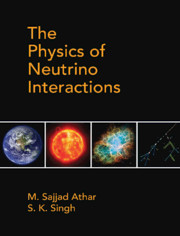Book contents
- Frontmatter
- Dedication
- Contents
- List of Figures
- List of Tables
- Preface
- Acknowledgments
- Chapter 1 Neutrino Properties and Its Interactions
- Chapter 2 Relativistic Particles and Neutrinos
- Chapter 3 Quantization of Free Particle Fields
- Chapter 4 Interacting Fields and Relativistic Perturbation Theory
- Chapter 5 Phenomenological Theory I: Nuclear β-decays and Weak Interaction of Leptons
- Chapter 6 Phenomenological Theory II: Weak Decays of Hadrons
- Chapter 7 Gauge Field Theories and Fundamental Interactions
- Chapter 8 Unified Theory of Electroweak Interactions
- Chapter 9 Neutrino and Electron Scattering from Point Particles
- Chapter 10 Neutrino scattering Cross Sections from Hadrons: Quasielastic Scattering
- Chapter 11 Neutrino Scattering from Hadrons: Inelastic Scattering (I)
- Chapter 12 Neutrino Scattering from Hadrons: Inelastic Scattering (II)
- Chapter 13 Neutrino Scattering from Hadrons: Deep Inelastic Scattering
- Chapter 14 Weak Quasielastic v(⊽)-nucleus Scattering
- Chapter 15 Inelastic Scattering of (Anti)neutrinos from Nuclei
- Chapter 16 Deep Inelastic Scattering of (Anti)neutrinos from Nuclei
- Chapter 17 Neutrino Sources and Detection of Neutrinos
- Chapter 18 Neutrino Mixing and Oscillations
- Chapter 19 Neutrino Astrophysics and the Synthesis of Elements
- Chapter 20 Neutrino Interactions Beyond the Standard Model
- Appendices
- Appendix A Lorentz Transformation and Covariance of the Dirac Equation
- Appendix B Cabibbo Theory
- Appendix C Some Properties of Pauli and Dirac Matrices and Spin Density Matrices
- Appendix D Leptonic and Hadronic Tensors
- Appendix E General Expression for the Total Scattering Cross Section and Decay Rates
- Appendix F Expressions of N(q2), the Coefficients of the Polarization Observables
- References
- Index
Chapter 11 - Neutrino Scattering from Hadrons: Inelastic Scattering (I)
Published online by Cambridge University Press: 22 May 2020
- Frontmatter
- Dedication
- Contents
- List of Figures
- List of Tables
- Preface
- Acknowledgments
- Chapter 1 Neutrino Properties and Its Interactions
- Chapter 2 Relativistic Particles and Neutrinos
- Chapter 3 Quantization of Free Particle Fields
- Chapter 4 Interacting Fields and Relativistic Perturbation Theory
- Chapter 5 Phenomenological Theory I: Nuclear β-decays and Weak Interaction of Leptons
- Chapter 6 Phenomenological Theory II: Weak Decays of Hadrons
- Chapter 7 Gauge Field Theories and Fundamental Interactions
- Chapter 8 Unified Theory of Electroweak Interactions
- Chapter 9 Neutrino and Electron Scattering from Point Particles
- Chapter 10 Neutrino scattering Cross Sections from Hadrons: Quasielastic Scattering
- Chapter 11 Neutrino Scattering from Hadrons: Inelastic Scattering (I)
- Chapter 12 Neutrino Scattering from Hadrons: Inelastic Scattering (II)
- Chapter 13 Neutrino Scattering from Hadrons: Deep Inelastic Scattering
- Chapter 14 Weak Quasielastic v(⊽)-nucleus Scattering
- Chapter 15 Inelastic Scattering of (Anti)neutrinos from Nuclei
- Chapter 16 Deep Inelastic Scattering of (Anti)neutrinos from Nuclei
- Chapter 17 Neutrino Sources and Detection of Neutrinos
- Chapter 18 Neutrino Mixing and Oscillations
- Chapter 19 Neutrino Astrophysics and the Synthesis of Elements
- Chapter 20 Neutrino Interactions Beyond the Standard Model
- Appendices
- Appendix A Lorentz Transformation and Covariance of the Dirac Equation
- Appendix B Cabibbo Theory
- Appendix C Some Properties of Pauli and Dirac Matrices and Spin Density Matrices
- Appendix D Leptonic and Hadronic Tensors
- Appendix E General Expression for the Total Scattering Cross Section and Decay Rates
- Appendix F Expressions of N(q2), the Coefficients of the Polarization Observables
- References
- Index
Summary
Introduction
The inelastic scattering processes of (anti)neutrinos from nucleons arerelevant in the region starting from the neutrino energy corresponding tothe threshold production of a single pion. For neutral current (NC) induced1π production, this starts at Ethv(⊽) = 144.7 MeV forvl reactions. In the case of charged current(CC) induced 1π production, the threshold energy ishigher because of the massive leptons produced in the final state; itcorresponds to Ev (⊽)≥ 150.5 MeV (277.4 MeV) for ve(nm) reactions. As the neutrino energy increases,inelastic processes of multiple pion production, viz.,2π, 3π, etc., and theproduction of strange mesons (K) and hyperons(Ⲩ) start; both of which are the most relevantinelastic processes in the region of a few GeV. These inelastic processeshave been studied very extensively, both theoretically and experimentally,in various reactions induced by photons and electrons which probe theinteraction of the electromagnetic vector currents with hadrons in thepresence of other strongly interacting particles like mesons and hyperons.In weak processes induced by neutrinos and antineutrinos, the inelasticprocesses provide a unique opportunity to study the interaction of the weakvector as well as the axial vector currents with hadrons in the presence ofstrongly interacting particles like mesons and hyperons. Moreover, a studyof these weak processes from nucleons and nuclei is of immense topicalimportance in the context of the present neutrino oscillation experimentsbeing done with the accelerator and atmospheric neutrinos in the energyregion of a few GeV. The specific reactions to be studied in the inelasticchannels are the various processes induced by the charged and neutral weakcurrents of neutrinos and antineutrinos, given in Table 11.1.
The first four reactions in Table 11.1 are strangeness conserving (∆S= 0) reactions and the last one is a strangeness changing (∆S = 1)reaction. The generic Feynman diagrams describing these reactions are shownin Figures 11.1(a) and 11.1(b), wherevl(⊽l) andl-(l+)
are leptons interacting through theW±(Z) exchanges withthe nucleon (N) producing the final nucleon(N') and hyperons(Ⲩ) and mesons like pions(π) and kaons (K).
- Type
- Chapter
- Information
- The Physics of Neutrino Interactions , pp. 425 - 477Publisher: Cambridge University PressPrint publication year: 2020



